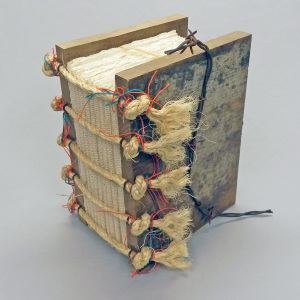 For those of you who know my work, this book is different from my past books, and yet, this book is about nothing but the past. The barbed wire serves a purpose, which I will get to eventually. The book contains ten codices, each comprised of three sheets of rustic acid free paper made from scraps from past book projects and generous inclusions of paypyrus and raffia. I used my father’s 1946 portable Smith Corona manual typewriter for the text, and papyrus on which to type because the typewritten characters reminded me of the hieroglyphs used on the papyri of ancient Egypt. I should probably point out, the spell check feature was not always working properly. Maybe someday, some archaeologist will pore over my texts in the hopes they can translate the strange characters. Papyrus survives better almost anywhere other than Puget Sound, so to ensure my writings would be better preserved, I mounted the papyri onto the sheets of rustic hand moulded paper which make up the codices.
For those of you who know my work, this book is different from my past books, and yet, this book is about nothing but the past. The barbed wire serves a purpose, which I will get to eventually. The book contains ten codices, each comprised of three sheets of rustic acid free paper made from scraps from past book projects and generous inclusions of paypyrus and raffia. I used my father’s 1946 portable Smith Corona manual typewriter for the text, and papyrus on which to type because the typewritten characters reminded me of the hieroglyphs used on the papyri of ancient Egypt. I should probably point out, the spell check feature was not always working properly. Maybe someday, some archaeologist will pore over my texts in the hopes they can translate the strange characters. Papyrus survives better almost anywhere other than Puget Sound, so to ensure my writings would be better preserved, I mounted the papyri onto the sheets of rustic hand moulded paper which make up the codices.
On the front piece of each codice is a small India ink illustration relative to either a story within, or the theme of the codice itself, each codice having its own theme which is often literary in nature. For example, one is titled Crime and Punishment, another is Animal Farm. The codices lie loose within a Coptic style cover made of repurposed wood which once served to make the forms for pouring my patio. Manila hemp binds the covers together, while weathered gate latches hold the book closed, and allow the codices to be held tightly in place when the book is placed in an upright position. As a final note, a buffer sheet on the inside of each cover helps protect the leaves of the codices from residual acids and lignins within the wood.
The project began as a search for provenance. Who am I? Where have I been? Why do I do what I do? The quest for memories that might explain or even answer these questions led to the realization, I might as well begin a conversation with a brick wall about what is art? What I learned, however, was while most memories become blurred by time or for whatever reason, many remained as sharp as the line of India ink I had just made on a sheet of paper. As I jotted and typed, a common thread began to emerge. The memories my brain had chosen to embrace, contained elements of the unexpected. Those moments make up the context of this book.
Which, brings us to the barbed wire. Those rusty barbs are a reminder of one of those moments. As we run through life groping blindly in front of us, we are in fact, often playing hide and go seek in the dark. No matter how well we think we plot and plan, nothing is ever certain. The barbed wire is meant to serve only as a reminder of that fact and not as a deterrent to playing the game. Always be curious. Embrace the unexpected. As a footnote, the inverted Ω on the front piece of each codex is a personal symbol representing nothing is forever, but nothing truly ends.
